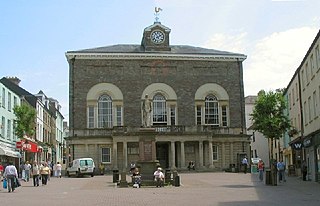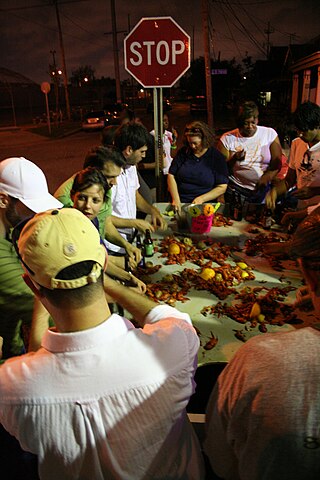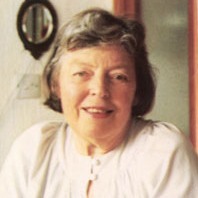
Shellfish is a colloquial and fisheries term for exoskeleton-bearing aquatic invertebrates used as food, including various species of molluscs, crustaceans, and echinoderms. Although most kinds of shellfish are harvested from saltwater environments, some are found in freshwater. In addition, a few species of land crabs are eaten, for example Cardisoma guanhumi in the Caribbean. Shellfish are among the most common food allergens.

Carmarthenshire is a county in the south-west of Wales. The three largest towns are Llanelli, Carmarthen and Ammanford. Carmarthen is the county town and administrative centre. The county is known as the "Garden of Wales" and is also home to the National Botanic Garden of Wales.

A raw bar is a small restaurant or a bar within a restaurant where live shellfish are shucked and served. Raw bars typically offer a variety of raw and cooked seafood and shellfish that is served cold. Seafood-based dishes may also be offered, and additional, non-seafood foods may also be part of the fare. Raw bars may offer alcoholic beverages such as oyster shooters, as well as wine and sake that is paired with various foods. Additional accompaniments may include condiments, sauces and foods such as lemon and lime. Several restaurants in the United States offer raw bars, some of which are seasonal.

Seafood boil in the United States is the generic term for any number of types of social events in which shellfish, whether saltwater or freshwater, is the central element. Regional variations dictate the kinds of seafood, the accompaniments and side dishes, and the preparation techniques. In some cases, a boil may be sponsored by a community organization as a fund-raiser or a mixer. In this way, seafood boils are like a fish fry, barbecue, or church potluck supper. Boils are also held by individuals for their friends and family for a weekend get-together and on the holidays of Memorial Day and Independence Day. While boils and bakes are traditionally associated with coastal regions of the United States, there are exceptions.

Gathering seafood by hand can be as easy as picking shellfish or kelp up off the beach, or doing some digging for clams or crabs, or perhaps diving under the water for abalone or lobsters.
The Shellfish Association of Great Britain (SAGB) is a historic association that was founded as the Oyster Merchants' and Planters' Association in 1903, it was renamed the SAGB in 1969. They cover a wide range of topics within the shellfish industry, from trading to advice on nutritional standards and also the sustainability of the industry.

The cuisine of Gower, a peninsula in south Wales, is based on ingredients grown, raised or collected on or around the peninsula. The cuisine is based on fresh ingredients with recipes based around a fish or meat dish. Until the twentieth century, the peninsula was virtually cut off from other markets due to poor roads, and no rail connection. The result was that Gower became self-sufficient in food.

Known as The Garden of Wales, Carmarthenshire is a county of rich, fertile farmland and productive seas and estuaries, that give it a range of foods that motivate many home cooks and restaurateurs. There is a local tradition in brewing, milling, gathering shellfish from the coasts and meat production. Carmarthenshire has been described by The Daily Telegraph as a "worthwhile destination for foodies" with the county having a modest matter of fact excellence. Carmarthenshire has ambitions to become the premier food-producing county of Wales, based on its strong reputation for first-class products. and Carmarthenshire County Council produces its own on-line and hard-copy recipe book called Taste from Carmarthenshire, for those interested in learning more about the county's cuisine.

A seafood restaurant is a restaurant that specializes in seafood cuisine and seafood dishes, such as fish and shellfish. Dishes may include freshwater fish. The concept may focus upon the preparation and service of fresh seafood,. Some seafood restaurants also provide retail sales of seafood that consumers take home to prepare. Seafood restaurants may have a marine-themed decor, with decorations such as fish nets, nautical images and buoys. Fare can vary due to seasonality in fish availability and in the fishing industry. Seafood restaurants may offer additional non-seafood items, such as chicken and beef dishes.

Welsh cuisine encompasses the cooking styles, traditions and recipes associated with Wales. While there are many dishes that can be considered Welsh due to their ingredients and/or history, dishes such as cawl, Welsh rarebit, laverbread, Welsh cakes, bara brith and Glamorgan sausage have all been regarded as symbols of Welsh food. Some variation in dishes exists across the country, with notable differences existing in the Gower Peninsula, a historically isolated rural area which developed self-sufficiency in food production.

Pembrokeshire has been called "the cottage garden of Wales", due to its good soil and the beneficial effects of the Gulf Stream, which provide a mild climate and a longer growing season than other parts of the country. The good climate and soil meant that the south of the peninsula was coveted by the Norsemen and Normans because it had "great plentie" of corn and cattle The county has prime agricultural land, much of which is located at about 70m above sea level, while to the north, the Preseli Hills rise to 500m above sea level and form uplands that are made up of heather and bracken, which are used for grazing sheep. Consequently, Pembrokeshire is classed as one of the most fertile counties in Wales, with its 392,300 agricultural acres having 14% of its land classed as of good quality, 67% being classed as medium quality and 19% being classed as poor quality. However, agricultural production is subject to market forces and in the 1890s, as a result of the Panic of 1893, a deep agricultural depression led to the area under cultivation falling by a third. Many labourers and farmers had no option but to emigrate to the New World and many of the large farming estates were sold. World War I brought prosperity again, but by the 1930s, as a result of the Great Depression, there was another agricultural depression which lasted until World War II. During the Post-war period agriculture has benefited from marketing schemes and marketing boards, which have helped in the regulation, marketing and distribution of the county's agricultural production.
The coast of Ceredigion is made up of a long coastal plain that contains high cliffs, coves, large bays and estuaries. The coastal plain gets narrower towards the more mountainous north of the county and is cut by the wide estuaries of the Teifi and the Dyfi. The broad and fertile Teifi valley is ideal for dairy farming and mixed farming. Heavy rainfall washes the minerals out of the soil and results in the mountainous areas of the county having relatively poorer, acidic soils. The plough line can be as low as 700 feet, which restricts cultivation.

Bobby Freeman was a writer, journalist, television presenter and cook who is known for her writing on Welsh cuisine.

The cuisine of Monmouthshire is historically associated with Lady Augusta Hall, who was also known as Lady Llanover. Lady Llanover published one of the first Welsh cookery books called First Principles of Good Cookery. The book uses a fictional Welsh hermit to give culinary advice to a visiting guest who is travelling though Wales.

The Anglesey Oyster and Welsh Produce Festival is an annual food festival that was established in 2006 and is held during October in Anglesey, Wales.

The cuisine of the Vale of Glamorgan, Wales, is noted for its high-quality food produced from the fertile farmland, river valleys and coast that make up the region. The area has a long history of agriculture that has developed from the Roman era.














